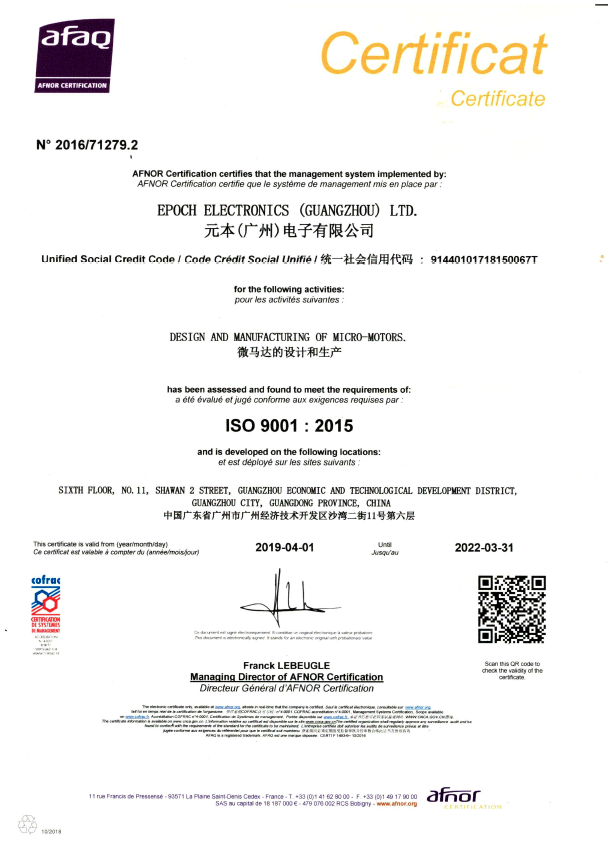Some of your Questions:
- Q1. Did Epoch get certified to ISO9001/IATF 16949?
- Q2. What are the characteristics of stepping motors?
- Q3. What is the step angle?
- Q4. What is the microstepping
- Q5. How to deal with stalling?
- Q6. How to reduce motor vibration?
- Q7. What type of the stepper motor sold by Epoch?
- Q8. What is the step angle?
- Q9. What is the microstepping?
- Q10. How to deal with stalling?
- Q11. How to reduce motor vibration?
- Q12. What are the characteristics of stepper motors?
- Q13. How to deal with the noise of the motor drive signal?
Q1. Did Epoch get certified to ISO/TS 16949?
Yes. Epoch got certified to ISO9001:2015/IATF16949:2016 for design and the manufacturing of micor-motors.


Q2. What are the characteristics of stepping motors?
High torque at low speeds, and higher holding torque.
A pulse signal input is equal to one step angle of the motor, which is relatively easy to control the motor rotation angle.
Open-loop control using digital pulse signals makes the system simpler and low cost.
The rotation angle deviation does not accumulate.
One type of the brushless motor.
Fast response, easy to start, stop, forward and reverse transformation, acceleration and deceleration changes.
Q3. What is the step angle?
This is the basic angle at which the driver sends a pulse signal to turn the motor. A complete 360 degrees circle divided by the step angle is the number of steps per motor revolution. For example, each full step of 7.5 degrees is a common step size rating, which is equivalent to 48 steps per revolution. The Epoch step motor has 0.9 and 1.8 degrees for HB, and PM has 3.7 degrees, 7.5 degrees, 15 degrees, and 18.0 degrees.
Q4. What is the microstepping?
The step motor has a fixed number of steps per revolution. Microstepping is a way of increasing the number of steps by sending a sine/cosine waveform to the coils inside the stepper motor, which allows stepper motors to run smoother in low speed.
Q5. How to deal with stalling?
It is recommended that the motor speed be slower or the acceleration/deceleration time be extended to confirm whether the motor PO torque cannot overcome the system dynamic load
If it happend in the stationary, check whether the system static load has exceeded the holding torque.
Check if the motor lead wire is badly soldered and whether it is connected to the controller signal.
Check if the signal sent by the driver is disturbed.
Check if the motor input current has reached the set value.
Check the motor surface temperature, the high temperature will cause the torque to drop, in the worst case even the permanent demagnetization of the magnet.
Q6. How to reduce motor vibration?
The stepper motor is driven by a pulse signal. Therefore, it is normal for the vibration to be felt by touching the motor housing with a hand during operation.
The natural frequency of the stepping motor is in the low frequency range. It is recommended to operate at 400PPS or more. It can also be driven by half step or microstepping.
Reduce the motor current.
Confirm if the motor cable pins are correct, or whether the driver side welding is correct.
Q7. What type of the stepper motor sold by Epoch?
Permanent magnet(PM) and hybrid(HB) stepper motors. For more product information, please refer to the product information link.
Q8. What is the step angle?
Step angle means the basic angle at which the driver sends a pulse signal to turn the motor. A complete 360° circle divided by the step angle is the number of steps per revolution of the motor. For example, the 7.5°stepper motor is equivalent to 48 steps per revolution. The Epoch stepper motor has 0.9° and 1.8° for HB, and 3.75°, 7.5°, 15°, 18° for PM.
Q9. What is the microstepping?
The stepper motor has a fixed number of steps per revolution. Microstepping is a way of increasing the number of steps by sending a sine/cosine waveform to the coils inside the stepper motor, which allows stepper motors to run smoother in low speed.
Q10. How to deal with stalling?
It is recommended that the motor speed be slower or the acceleration/deceleration time be extended to confirm whether the motor torque cannot overcome the system dynamic load.
If it happened in starting, check whether the system static load has exceeded the holding torque.
Check if the motor lead wire is badly soldered and whether it is connected to the controller signal.
Check if the signal sent by the driver is disturbed.
Check if the motor input current has reached the set value.
Check the motor surface temperature, the high temperature will cause the torque to drop, in the worst case even the permanent demagnetization of the magnet.
Q11. How to reduce motor vibration?
The stepper motor is driven by a pulse signal. Therefore, it is normal for the vibration to be felt by touching the motor housing with a hand during operation.
The natural frequency of the stepper motor is in the low frequency range. It is recommended to operate at 400PPS or more. It can also be driven by half step or microstepping.
Reduce the input current.
Confirm if the motor cable pins are correct, or whether the driver side welding is correct.
Q12. What are the characteristics of stepper motors?
High torque at low speeds and higher holding torque.
A pulse signal input is equal to one step angle of the motor, which is relatively easy to control the motor rotation angle.
Open-loop control using digital pulse signals makes the system simpler and low cost.
The rotation angle deviation does not accumulate.
One type of the brushless motor.
Fast response, easy to start and stop, forward and reverse transformation, acceleration and deceleration changes.
Q13. How to deal with the noise of the motor drive signal?
Between driver and pulse generator : A. Shorten the wiring length B. The signal line is far away from the power
Between driver and power supply : A. Reduce noise with filters B. Confirm that the grounding is correct
